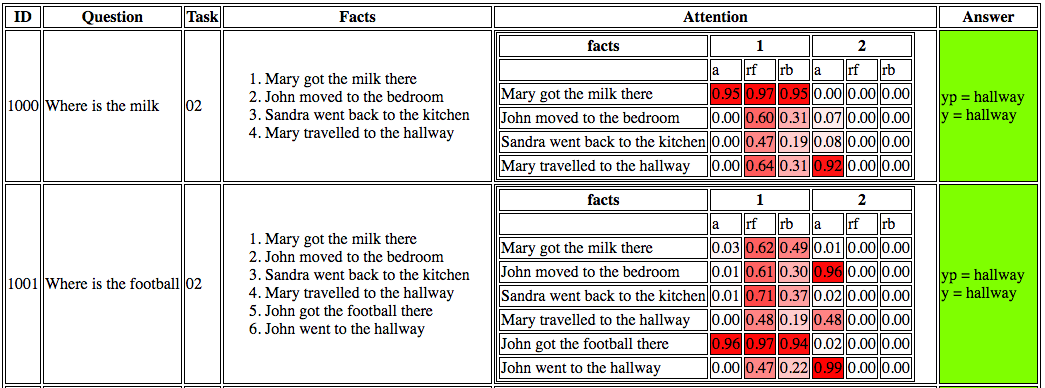 QRN is a purely sequential model like LSTM or GRU (but simpler than them) for story-based question answering (bAbI QA tasks).
QRN is implemented using TensorFlow.
Here are some notable results (error rates in %) on bAbI QA 1k dataset:
QRN is a purely sequential model like LSTM or GRU (but simpler than them) for story-based question answering (bAbI QA tasks).
QRN is implemented using TensorFlow.
Here are some notable results (error rates in %) on bAbI QA 1k dataset:
| Task | LSTM | MemN2N | Ours (2rb) |
|---|---|---|---|
| 2 | 80.0 | 18.8 | 0.7 |
| 3 | 80.0 | 31.7 | 5.7 |
| 4 | 39.0 | 17.5 | 0.0 |
| 5 | 30.0 | 12.9 | 1.1 |
| avg | 51.3 | 15.2 | 9.9 |
See model details and more results in this paper.
We are assuming you are working in a Linux environment.
Make sure that you have Python (developed on 3.5), and you installed these Python packages: tensorflow (0.8 or higher, get it here), and progressbar2.
First, download bAbI QA dataset (note that this downloads the dataset to $HOME/data/babi):
chmod +x download.sh; ./download.sh Then preprocess the data for a particular task, say Task 2 (this stores the preprocessed data in data/babi/en/02/):
python -m prepro --task 2Finally, you train the model (test is automatically performed at the end):
python -m babi.main --noload --task 2It took ~3 minutes on my laptop using CPU.
You can run it several times with new weight initialization (e.g. 10) and report the test result with the lowest dev loss:
python -m babi.main --noload --task 2 --num_trials 10This is critical to stably get the reported results; some weight initialization leads to a bad optima.
After training and testing, the result is stored in evals/babi/en/02-None-00-01/test_0150.json.
We can visualize the magnitudes of the update and reset gates using the result file.
Note that you need jinja2 (Python package).
Run the following command to host a web server for visualization and open it via browser:
python -m babi.visualize_result --task 2 --open Truethen click the file(s). It takes a a few seconds to load the heatmap coloring of the gate values. You will see something like this:
By default visualize_result retrieves the first trial (1).
If you want to retrieve a particular trial number, specify the trial number if --trial_num option.
To train the model on 10k dataset, first preprocess the data with large flag:
python -m prepro --task 2 --large TrueThen train the model with large flag as well:
python -m babi.main --noload --task 2 --large True --batch_size 128Note that the batch size is increased to 128.
Finally, visualization requires the large flag:
python -m babi.visualize_result --task 2 --open True --large TrueTo control other parameters and see other options, type:
python -m babi.main -hTo train the model on bAbI dialog, preprocess the data with bAbI dialog dataset:
python -m prepro-dialog --task 2Then train the model:
python -m dialog.main --noload --task 2To use match, use_match flag is required:
python -m dialog.main --noload --task 2 --use_match TrueTo use RNN decoder, use_rnn flag is required:
python -m dialog.main --noload --task 2 --use_rnn True